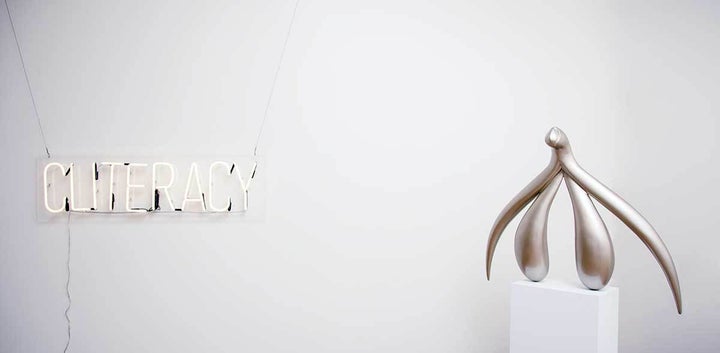This article was originally published on Healthline.com

The world isn’t flat and women don’t orgasm from their vaginas.
For years, conceptual artist Sophia Wallace has been spreading cliteracy throughout the land: educating both women and men about the central truths of female pleasure and female sexuality. Through her mixed media art installations, she shares this central message: the clitoris has a right to being and women have a right to pleasure.
It sounds simple, but it’s not.
These are some of the same statements she hears, again and again, as she speaks to women around the world:
I never thought women were sexual like that.
I could never say that word out loud.
I never knew the anatomy of the clitoris.
I always thought my body just didn’t work.
Wallace fights back against these misconceptions first and foremost with her art: providing men and women with visual representations of female pleasure and female anatomy, paired with powerful statements that shatter taboos.
“In terms of the visual representation of sex, the clit doesn’t exist at all,” Wallace explained. “There’s never a natural beautiful image of a woman or man touching a clit. It’s treated as very crass. Penetration is great, but the idea that you can never talk about the pleasure of the clit is akin to the idea that the earth is flat. Just because it offended people that the earth is not the center of the universe doesn’t mean it’s not true.”
Wait, why is an artist educating us about our bodies?
It might at first seem strange that an artist — and not a doctor or scientist — is trying to educate the world’s women about female anatomy, orgasm, and pleasure. But to Wallace, it makes perfect sense.
“Science is necessary,” she said. “But what artists are charged with is to ask questions that no one else is asking. We’re supposed to be looking at the world from another perspective. Western medicine and science have been complacent in a lot of awful bogus ideas, especially with women and with minorities.”
Wallace is right.
For much of history, including up to the present day, the clitoris and the female orgasm have been ignored, misunderstood, and largely unstudied, especially in comparison with male genitals and male sexual pleasure. The reasons are many, but have their roots in sexism: the researchers and scientists were overwhelmingly men, who overwhelmingly saw women as passive beings who didn’t require physical pleasure.
Wallace’s art seeks to give a voice and a face to female pleasure.

The billboard was on view in November on I-25 Southbound near mile marker 247.2. I was pleased by the range of comments we received from the billboard exhibition, such as "What are you trying to sell?" and "How do I explain this to my son?"
One of her pieces, “100 Natural Laws,” is a 10x13 foot panel that shares 100 statements about female pleasure, from simple facts: “Penetration is just one of innumerable ways to have sex,” to bold statements — “Be real: Sex is primarily about pleasure, not reproduction.” Another project focuses on street art: spray painting the image of the clitoris in urban spaces — mirroring the phallic symbols so common in graffiti. All of these projects strive to open discussion about female sex, while helping women shed shame and jettison misinformation.
““Don’t sleep with anyone who doesn’t care about attending to your body.””
- Sophia Wallace
Shattering 3 misconceptions about the clitoris and female sexuality
The first step to achieving cliteracy is to stamp out long-held myths regarding female pleasure. Here are three places Wallace would like to start:
Misconception 1: It’s always inappropriate to talk about female genitalia
Shaming and silencing people for talking about female pleasure is a means of control. While it might not be ideal to talk about the clitoris at certain times or in certain places, shattering the notion that we can never openly talk about how we feel and what we want related to female sex is central to moving forward.
Sex shouldn’t be defined by penetration.
“Sex shouldn’t be defined by penetration.”
“If there’s not a place in public discourse to talk about female genitals, it makes it really easy to take away women’s rights,” Wallace said. “When it comes to male bodies, there’s so much respect for their bodily integrity and their right to pleasure. We talk about Viagra, penis pumps, condoms that are made as thin as possible for their pleasure. On our side, we fight for every tiny bit, from birth control to our right to pleasure.”
Misconception 2: Penetrative orgasms aren’t the ultimate goal
The vagina isn’t the inverse of the penis, and the woman isn’t a strictly passive participant in the sex act. So it follows that penetrative orgasms shouldn’t necessarily be what women are striving for in the bedroom.
“The idea of us being opposite is not true,” said Wallace. “We’re not exactly the same, of course not, but we are more similar than different. We are not the object versus the void. If you really know the female anatomy, that is clear. And male bodies can be receptive and be penetrated.”
Sex shouldn’t be defined by penetration if we want sex to be supremely pleasurable for women, and research shows that vaginal orgasms are weaker and harder to achieve — if they exist at all.
“Being queer, lesbians are having a very different experience with sex and our bodies,” said Wallace. “Even saying the word sex and what that means, and getting beyond sex revolving around a penis penetrating a vagina. Queer sex is about mutually pleasuring each other until everyone is satisfied.”
Misconception 3: Female pleasure is shameful
“People are told by science, religion, and pop culture that women aren’t as sexual,” said Wallace. “They’re told their natural desire is family and security, that they don’t have a natural biological desire to get off like people with penises. So, women blame themselves when they aren’t being sexually satisfied.”
So many issues holding women back from fully embracing female pleasure can be traced back to shame. Many women have been told for their whole lives that female desire is only to be desired. Let’s change that by getting cliterate.
A few ways to start getting cliterate
How can you become cliterate? Here are some places to start.
Cliteracy basics
- Know your own anatomy.
- Make sure your partner cares about your pleasure.
- Do some research.
- Understand how to improve your sexual health.
1. Know your own anatomy: Most people can draw a penis, but few can draw an anatomically correct clitoris. “I want the form of the clitoris to be known,” said Wallace. “I want it to be an icon and a symbol that is recognized. I want it never to be forgotten again.” Understanding your body is vital to having pleasurable, healthy sex, and knowing how to orgasm.

2. Make sure your partners care about your pleasure: Your partner in the bedroom should also not be under the misconception that women aren’t sexual, that penetrative sex is the ultimate pleasure, or that women’s bodies are shameful. “Don’t sleep with anyone who doesn’t care about attending to your body,” said Wallace. “Giving a woman pleasure should be part of their pleasure.”
For example, direct stimulation to the clitoris can be too much, but your partner won’t know unless you tell them — or you’re both cliterate. Practice touching around the clitoris in a circular or up-and-down motion instead. Don’t be afraid to experiment!
3. Do some research: Wallace has a 20-minute TEDx talk that reviews all of the basics of being cliterate — and while not enough research has been done about the clitoris and female sexuality, some does exist. Another good place to start? This award-winning animated short by French filmmaker Lori Malépart-Traversy which is just three minutes long but filled with history and information.

4. Understand that being cliterate can improve your sexual health: Simply talking to your partner about how you like being touched, and communicating about needs like clean hands, safe sex, and lubricant, can mean not only a healthier sex life, but a healthier body: a decreased chance of STIs, UTIs, and yeast infections, just to start.
“We don’t need to carry shame anymore,” Wallace said. “Imagine if there was a monument in the world that told girls that they had a right to feel good, and showed the truth of how their body actually is. What would life be like for future women?”
All photos courtesy of Sophia Wallace unless otherwise stated. You can follow Sophia Wallace and her art through her website, Instagram, Twitter, and Facebook. Prints and jewelry related to Cliteracy is also available on her shop.